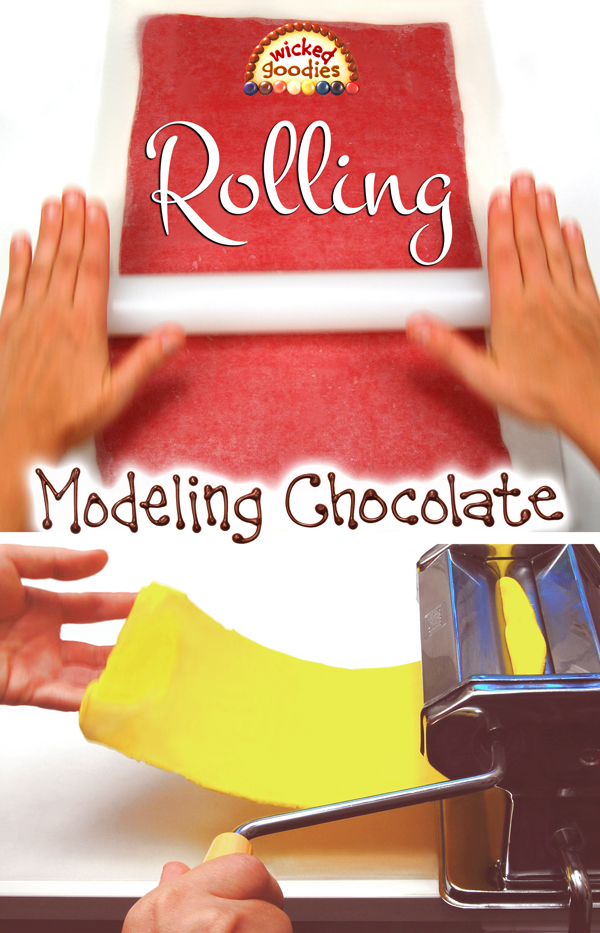
Using both a pasta machine and a plastic rolling pin, these two video tutorials demonstrate how to roll modeling chocolate. For thinner, more consistent sheets of modeling chocolate, I recommend using the pasta machine method.
How to Roll Modeling Chocolate by Hand
VIDEO: How to Roll Modeling Chocolate with a Rolling Pin
Step-by-Step Instructions
- Knead the modeling chocolate until it is pliable but still firm. Form it into a flat patty.
- Using a blush brush, lightly dust the top and bottom surfaces of the modeling chocolate with corn starch.
- Roll the modeling chocolate out evenly atop parchment paper with a plastic rolling pin.
- To achieve thin sheets, roll modeling chocolate between two pieces of parchment paper. If the parchment buckles as the chocolate stretches, peel it back to release the tension before resuming again.
- Once rolled, modeling chocolate will be soft, sticky, and sandwiched between two pieces of parchment paper. Allow it to rest for 10–30 minutes or until it’s firm enough to handle. Alternatively, place it in front of the cool blast of an air conditioner for 5-10 minutes.
Expert Option: Use the modeling chocolate immediately but work swiftly to minimize hand contact.
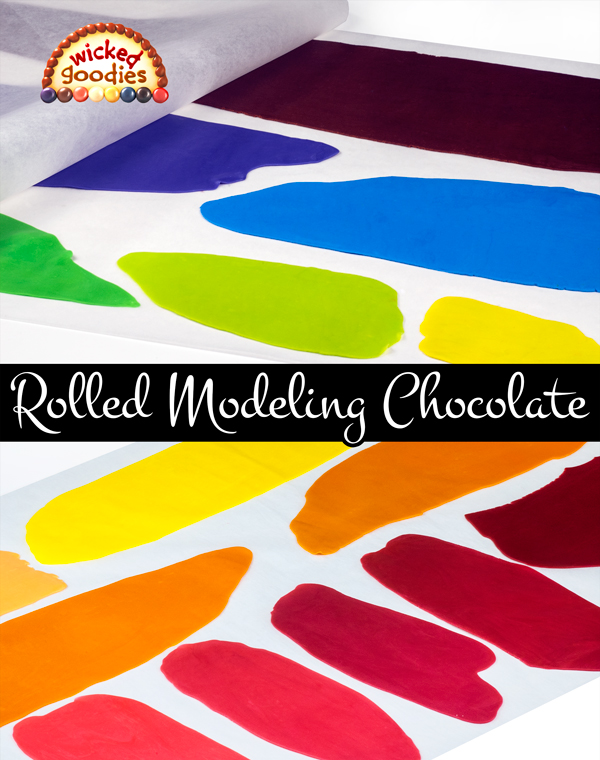
- Once the rolled modeling chocolate is firm like a fruit roll-up, peel and pull the top piece of parchment away. Note: Attempting to pull chocolate off parchment may cause it to tear. Instead, peel parchment away from chocolate.
- Using a blush brush, dust the top of the rolled modeling chocolate lightly with corn starch.
- Return the parchment paper to the top side and flip the sheet so that the bottom side faces up.
- Peel the remaining layer of stuck paper off the modeling chocolate and brush that side with corn starch as well. The modeling chocolate should no longer stick to the paper on either side and, so at this point, it can be moved, formed, or cut into decorations of any variety.
How to Roll Modeling Chocolate with a Pasta Machine
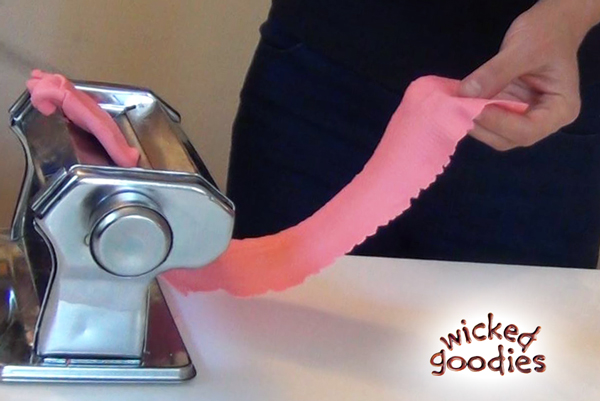
Because modeling chocolate has little elasticity, it can be rolled exceptionally thin for fine decorations. In high volume operations, chocolate may be rolled in a commercial sheeter using traditional all-purpose flour as the dusting agent. For home kitchens and smaller sized bakeries, passing modeling chocolate through a hand-cranked pasta machine using corn starch as the dusting agent yields formidable results.
Tip 1: Always roll modeling chocolate out onto parchment paper to avoid sticking.
Tip 2: When rolling, use modeling chocolate that is cool and firm. If modeling chocolate is too warm, it may cling to the gears and bunch underneath the rollers, in which case, allow it to cool and rest. If it’s too cold, it may shatter or resist rolling altogether, in which case, try kneading it.
VIDEO: How to Roll Modeling Chocolate with a Pasta Machine
Step-by-Step Instructions
- Begin by kneading the modeling chocolate until it’s pliable but still firm. Flatten it into a ½-inch (13 mm) thick patty with the palm of the hand. Pass it through the pasta machine on a thick setting.
- Fold the strip of chocolate back into a patty and then pass it through on a thinner setting. Continue this process, decreasing the setting even more, until the desired thinness is achieved. Avoid contact with the edges of the rollers, where chocolate may get stuck.
- When the desired thinness is achieved, place rolled sheets of modeling chocolate onto parchment paper, spacing them ½-inch (13 mm) apart.
- Holes or flaws in the texture are common and okay at this stage. Remove any unwanted bits with the tip of a knife. Plug any holes and reinforce any thin areas with extra scraps of modeling chocolate.
- Place another piece of parchment on top so that the rolled modeling chocolate is sandwiched between two pieces of paper. Flatten it by hand, pushing all the air bubbles out the edges. Roll firmly over the top with a rolling pin. This step will give the sheets a smooth finish and sheen.
- Proceed with Steps 5–9 of the Rolling by Hand Method demonstrated above.
Rolling Machine Maintenance
When rolling many colors of modeling chocolate in a row through a machine, work from lightest to darkest to prevent dark flecks from infiltrating lighter colors.
Keep the machine’s rollers clean and free of debris by passing an old piece of white modeling chocolate through between uses. Use the old chocolate like a lint brush, periodically running it between the rollers to pull flecks of color and stuck chocolate from the gears.
To perform a deeper cleaning of the rollers, open them to the widest setting and rub them thoroughly with a damp plastic scouring pad. Pass a paper towel through the machine several times on increasingly thinner settings to absorb the moisture and residues left behind. Allow the machine to dry for several hours before using it again.
Preserving Sheets and Decorations
Rolled modeling chocolate can remain exposed to the air for a much longer time than fondant without forming an elephant skin. However, if it is left uncovered, it will eventually grow stiff and brittle. To preserve the softness and pliability of rolled modeling chocolate decorations, cover them with plastic wrap. Store them on metal sheet pans in a cool place out of sunlight. To store rolled modeling chocolate for a number of days, sandwich it directly between two pieces of plastic wrap (parchment paper, over time, will draw moisture from modeling chocolate). For the best pliancy and performance, use modeling chocolate sheets within hours of rolling them.
Rolling Out Large Sheets
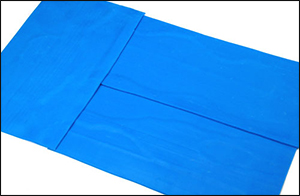
If a commercial sheeter is available, modeling chocolate can be rolled out to any size or thickness with ease. If a pasta machine is available, smaller pieces may be patched together to create larger ones. If only a rolling pin is available, large sheets may be rolled by hand between two pieces of parchment paper. However, it is easiest to achieve a consistent thickness using a machine.
Step-by-Step Patching Together Pieces to Form Sheets
- Begin by rolling out long strips of chocolate.
- With a roller cutter, trim any rough edges. Ball up the scraps for reuse.
- Piece together the strips, overlapping their edges by ¼ inch (6 mm) until the desired size and shape is achieved.
- Roll the chocolate between two pieces of parchment paper with a plastic rolling pin to smooth out the uneven surfaces and bind seams.
- Proceed with Steps 5 –9 Rolling by Hand.
This is a sample from the book
Cake Decorating with Modeling Chocolate

You might also enjoy
Recommended Modeling Chocolate Tools
Modeling Chocolate Basics
Modeling Chocolate Recipes

VIDEO: Marbled Modeling Chocolate Patterns
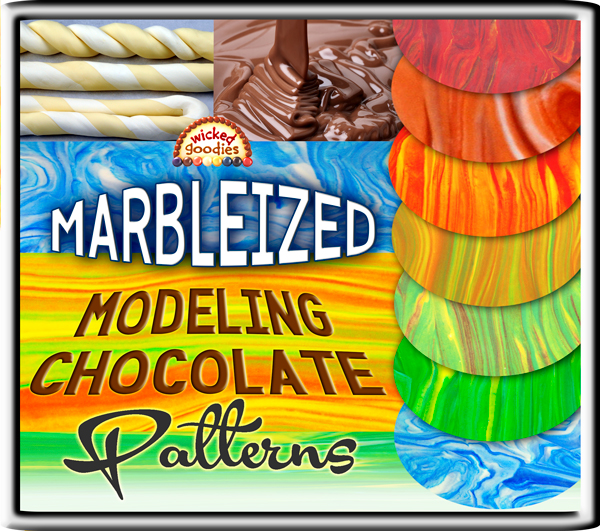
VIDEO: Leopard Print Modeling Chocolate Cake Wrap Tutorial
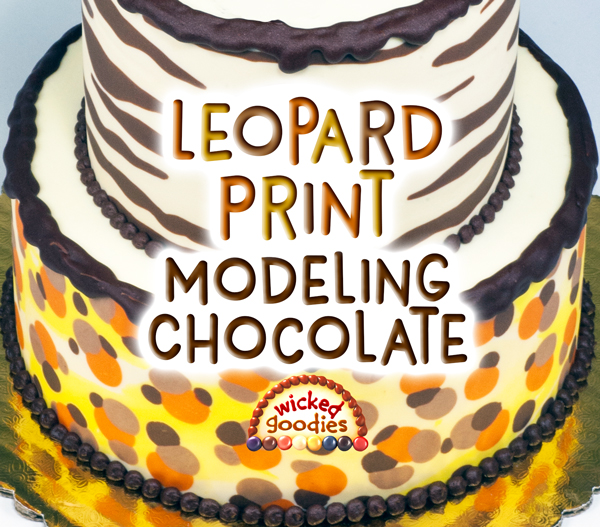
Modeling Chocolate Bow & Ribbon Tutorial
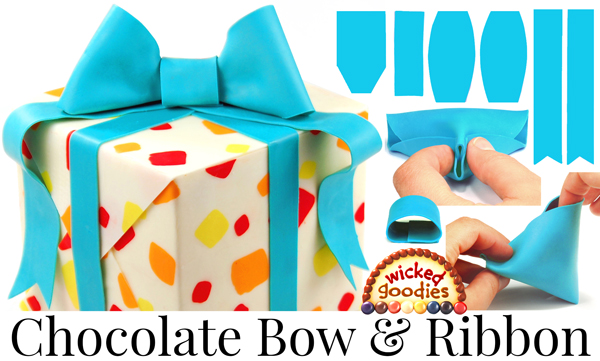

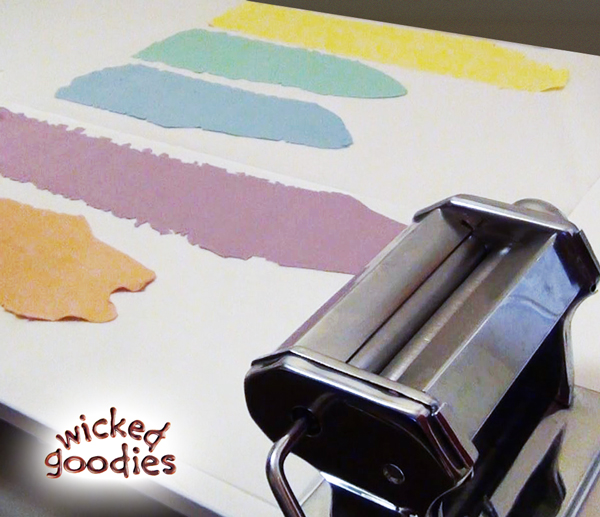






Hi. I am going to tackle making sea creatures out of modeling chocolate that will go on top of cupcakes. This will be my first time working with it. I’ll be making hermit crabs, stingrays, octopus, whales and jellyfish. Any hints on using the medium to make them? Will it stick to itself say when attaching parts? Thank you
Yes it will stick to itself as long as you attach the parts shortly after kneading, when the modeling chocolate is still tacky and pliable.
All my best tips are in this book: Cake Decorating with Modeling Chocolate.
I also recommend checking out this: 5 Modeling Chocolate Seashell Designs
and this: Modeling Chocolate Resource Guide
Thank you so much. It means a lot that you got back to me and I will check on getting your book as I do make a lot of cakes and it will add a whole new level of creativity.
Hi! I love this website and I am going to purchase the book. I am new to modeling chocolate. I just made your recipe and am waiting to see how it turns out. I am making a baby crib half sheet cake. I want to know how far in advance I can make the pieces of the crib – the spindles, head and foot boards? The actual sheet cake will be the mattress of the crib. I need the spindles to support the top rails. Thoughts?
You can start making the pieces 3-5 days in advance that the event. It’s very important to keep them in a cool dry place in the meantime.
Thank you Kristen. I made the recipe and the chocolate turned out great – after I let it dry some. It started out oily, but turned out quite nicely. I decided the crib was too much for my first go round with the chocolate. So, I made a teddy bear out of it, and three building blocks. The teddy bear is beautiful, a nice chocolate brown, he is sturdy. I placed a dowel thru his body and he isn’t going anywhere, smile. The blocks are just like small pieces of fudge. I am going to cover them in different colored fondant (I’m playing with that also). I made a baby carrier out of styrofoam covered in fondant, tossed a pink blankie inside and it looks unbelievable.
I do have one additional question though. Please forgive the naiveness of it. Would someone at the party expect to be able to eat the teddy bear, blocks, etc? Or is it a given that those type of decorations are not edible? I am not sure if I am wording my question correctly. I hope it make sense. Thank you again for taking the time to do what you do. It is a wonderful thing for us newbies to baking and modeling and fondanting!!!
Andrea,
The advantage to modeling chocolate over fondant for these types of decorations you describe is that it’s a pleasant experience eating them if anyone chooses to do so. Kids especially like to eat the decorations so yes, it happens. They don’t always get eaten though. It just depends on the crowd.
I’m so glad your cake came out well. It sounds awesome! I’d love to see photos if you are willing to share. There is the option to upload them to a comment here.
I would like to make a 3D wine bottle cake for my daughter’s birthday. All I seem to find is to cover it with gum paste or fondant, neither if which anyone in my family cares for! Would it be possible to cover it in modeling chocolate instead? If so is there a way to get a shine on the chocolate? Will a sugar sheet label affix to the molding chocolate?
I love your site. Thank you for the inspiration!
Ellen
You can use modeling chocolate to make the label.I don’t recommend attempting to cover a shape like that in modeling chocolate alone. It’s not stretchy enough to conform to those kinds of curves. You might consider mixing 50/50 modeling chocolate with fondant to improve the taste without losing the elasticity needed to wrap that kind of shape. You can affix a sugar sheet label to modeling chocolate. Modeling chocolate is naturally shiny but you can add even more shine by brushing it with luster dust.
What kind of chocolate to be used???
You can use any kind of chocolate to make modeling chocolate. Read more about the differences here.
Thanks for sharing this great information. God bless your heart. Please I’ll like to make a cake shoe box and cover it in modelling chocolate.side by side then make the lid differient. You have any idea the thickness and how to close up the edges to make it sharp?
Hi Abigail,
To make the lid of shoe box, cut even strips of modeling chocolate that are 1/4″ thick and run them around the top of the cake. To make sharp corners, you can trim along the edges of the modeling chocolate with a razor or craft utility knife.
I’m brasilian and I love the tutorial “ilusion”. Thank you for your generosity. How do I buy the book?
Thank you! The link for book buying options is right here: http://www.wickedgoodies.net/cake-decorating-with-modeling-chocolate/
I bake cake for family and friends, so I don’t have much knowledge about it. I started decorating cake with fondant, but in general here in Brazil, people don’t like fondant. I’m trying to find a substitute for it. Can I use modeling chocolate to cover cakes or it is only used for small pieces of decorations?
Renata
Yes you can absolutely use it to cover cakes. I typically use the paneling method to wrap cakes. There are detailed instructions on how to do it in my book.
I am a grandmother who likes to make cakes for my grand children. I like modeling chocolate above fondant or gum paste and the kids loved them because it tasted like tootsie rolls so I was using it for the last of couple of years for all my cakes but I would like to learn modern technique as used in all your decorations. Maybe you could teach how to make defying gravity cake decorations as a pouring wine bottle or tomato ketchup or syrup, all these illusions.
You are so creative in all your designs, thank you for the tutorials.
Berny
Yes it tastes just like a tootsie roll! I know there are some tutorials out there for those kinds of gravity defying cakes but I’ve never done one that looks like a bottle of liquid pouring myself.